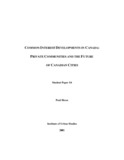| dc.contributor.author | Hesse, Paul | |
| dc.date | 2001 | |
| dc.date.accessioned | 2014-10-15T19:38:22Z | |
| dc.date.available | 2014-10-15T19:38:22Z | |
| dc.date.issued | 2014-10-15 | |
| dc.identifier.isbn | 1-894858-01-8 | |
| dc.identifier.uri | http://hdl.handle.net/10680/761 | |
| dc.description | Paper: 17 pp., Digital file. | en_US |
| dc.description.abstract | This paper examines the phenomenon of Common Interest Developments (CIDs), more commonly known as “gated
communities”, within the Canadian context. Comparing Canadian CIDs to their US counterparts. The author notes that
Canadian developments are more likely to target seniors, tend to have fewer security features and are usually developed
on a smaller scale. The author cautions that the proliferation of CIDs may have significant implications for local
politics and Canadian cities. CID residents in the US are gaining political clout through well-organized homeowner
associations, which constitute an effective lobbying force. Such associations are increasingly advocating measures
such as tax rebates for their constituency, arguing for an end to what they call “double taxation” since CID residents
pay both municipal taxes and monthly fees to the CID. The paper argues that CIDs are exclusionary by nature, fostering
homogeneity in age, race, and income group, and that the proliferation of such development will lead to greater
segregation in Canadian cities. | en_US |
| dc.description.sponsorship | Institute of Urban Studies | en_US |
| dc.language.iso | en | en_US |
| dc.publisher | Institute of Urban Studies | |
| dc.relation.ispartofseries | Student Paper;14 | |
| dc.rights | info:eu-repo/semantics/openAccess | |
| dc.subject | Gated communities -- Canada | en_US |
| dc.subject | Gated communities -- United States | en_US |
| dc.title | Common Interest Development in Canada: Private Communities and the Future of Canadian Cities | en_US |
| dc.type | Article | en_US |

